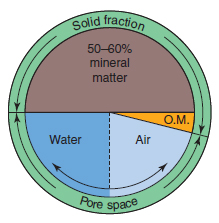Composition of soil
Content
Mineral soils form in layers of rock fragments over the Earth’s surface. They are made up of mineral matter comprising sand, silt and clay particles. There is also a small quantity of organic matter which is the part derived from living organisms. This framework of solid material retains water and gases in the gaps or pore space. The water contains dissolved materials including plant nutrients and oxygen and is known as the soil solution. The soil atmosphere normally comprises nitrogen, rather less oxygen and rather more carbon dioxide than in normal air, and traces of other gases. Finally, a soil capable of sustaining plants is alive with micro-organisms (organisms, such as bacteria, fungi and nematodes, too small to be seen with the naked eye). Larger organisms such as earthworms and insects are also normally present. The composition of a typical mineral soil is given in Figure 17.2, which also illustrates the variation that can occur. The content of the pore space varies continually as the soil dries out and is rewetted. The spaces can be altered by the compaction or ‘opening up’ of the soil which in turn has a significant effect on the proportions of air and water being held. Over a longer period the organic matter level can vary. The composition of the soil can be influenced by many factors and under cultivation these have to be managed to provide a suitable root environment. Organic soils have considerably higher organic matter content and are dealt with in Soil organic matter. |





